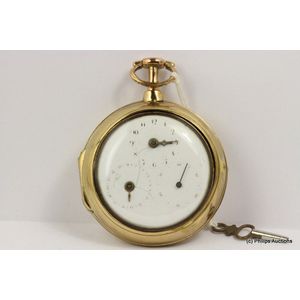Georgian Tri Dial Calendar Pocket Watch by John Howard London
You must be a subscriber, and be logged in to view price and dealer details.
Subscribe Now to view actual auction price for this item
When you subscribe, you have the option of setting the currency in which to display prices to $Au, $US, $NZ or Stg.
- Fusee - The fusee movement was used in clocks and pocket watches from the mid 17th century. The fusee is a cone shaped drum within the works that is linked to the barrel of the spring, usually by a length of chain.
As the mainspring loses its tension over time, the cone shaped barrel compensates for this by increasing the tension, by pulling the mainspring tighter, thus ensuring the time remains constant.
Use of the fusee in clocks was superseded by the "going barrel" in the mid 19th century and for pocket watches at the beginning of the 19th century.
The fusee continued to be used in marine chronometers until the 1970s. - Georgian - As an English stylistic period, Georgian is usually taken to cover the period from George I (1714) to the Regency of Prince George (1811-20), although the period from 1800 to 1830 is sometimes designated as the Regency period. During the Georgian period the great English cabinetmakers and designers such as Chippendale, Hepplewhite, Adam Sheraton etc., were all active.
Therefore there isn't a single 'Georgian style' as such and to say something is 'Georgian', usually means it was made between 1714 and 1830. This assumes we discount George V and George VI, both being from the 20th century.
The styles popular at the time of each reign were:
George I (1714-1727) saw out the last years of the Baroque period.
George II (1727-1760) reigned during the Rococo period.
George III (1760-1820) saw the last gasp of the Rococo, all of the early Neo-Classic 'Adam style' and most of the later neo-Classic 'Regency style'.
George IV (Prince Regent 1820-1830)encompassed the last of the 'Regency' style.
William IV's reign (1830-1837) was something of a no man's land (stylistically) and he wasn't a 'George' anyway. He covered the last glimmerings of 'Regency' and the start of the 'Victorian' style. - Movement - The technical name for the workings of a clock or watch, and does not include the dial or case.
This item has been included into following indexes:
Visually similar items

A Swiss gold open faced full sized chronograph pocket watch, 18ct yellow gold, case bears Swiss hallmarks Lw 18C/755 (Helvetia)919. Swiss made movement bears mark 'The Winner' split seconds chronograph with Sub dial for Consant seconds and split seconds, t

A silver pair cased open faced pocket by James wood Brighton, sterling silver, presented with polished outer case, white enamel dial, Arabic numerals, gold hands, elongated pendant, key wind, case hallmarked London 1800, John Bestall. Movement engraved Jam

A silver quarter repeater full calendar moonphase pocket, sterling silver, open faced with four sub dials, side winding, Swiss case hallmarked 9357079 3, movement unmarked full calendar moon phase quarter repeater, total weight: 132.1 grams

A silver full hunter pocket for Turkish market by Dent, 800 silver, case marked 'M' in star with wreath 80036139. Movement J Dent London 'M' in star with wreath made for Turkish market all Swiss first World War watch, total weight: 81.1 grams,
